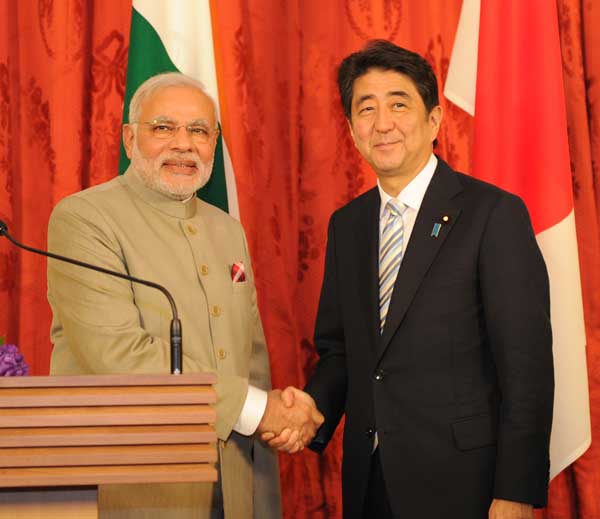IDR Blog
Japan & India Convergent Strategic Perspectives on ‘China-Threat’ Analysed

Japan and India while adhering to diplomatic niceties may under-play or de-emphasise the ‘China Threat’ as detrimental to Asian Security and to respective national security interests of Japan and India but undeniably the strategic reality is that it was their convergent strategic perspectives on ‘China Threat’ which strongly binds them in 2020 in Special Strategic Partnership.
Japan and India remarkably and coincidentally today have robust Prime Ministers at the helm in Japanese PM Abe and Indian PM Modi who in their respective Asian Nations have embarked on geopolitical and military measures to beef up national military capacities to ward-off any possible political or military coercion by China against Japan or India.
Japan and India coincidently stand afflicted by China with territorial disputes which defy any solution because Chinese claims to disputed areas are based on dubious claims. China even subjected India to a war of aggression in 1962 over its claims to disputed territorial claims. In case of Japan, Chinese military provocations in maritime areas around the Senkaku Islands claimed by China have become a regular feature.
Japan – India Global Special Strategic Partnership emerged at the turn of the Millennium and was coincident with the meteoric military rise of China in the first decade of 21st Century and China’s switch from ‘Soft Power’ Asian strategy of earlier decades to ‘Hard Power’ strategy in Asia as manifested by China’s military adventurism in South China Sea leading to ‘Full Spectrum Military Dominance’ of this critical maritime expanse vital for Asian and global security and economic well-being.
In tandem, China hardened and escalated its military stand-offs against India on the Himalayan Heights marking the borders of India with China Occupied Tibet as manifested on the months-long Dokalam Military Standoff in 2018 when India under PM Modi, unlike in preceding political dispensations squarely stared back at China.
Another dimension of the ‘China Threat’ to Japan and India stood manifested by China creating nuclear weapons proxies at Japan’s and India’s doorsteps in the form of North Korea and Pakistan. Both North Korea and Pakistan’s nuclear weapons and intermediate range missiles delivery means came into existence with China’s aid and technical assistance. North Korea is the regional spoiler state on China’s behalf in North East Asia and Pakistan distinguishes itself as the regional spoiler state in South Asia primarily aimed at India and tying down India within South Asian confines.
Both North Korea and Pakistan have been state-sponsors of terrorism and it is singularly noticeable that China as their ‘Patron Saint’ has not applied any pressures on these terrorist states to restrain their terrorism impulses in the neighbourhood.
Noticeably therefore, the ‘China Threat’ to Japan and India is not only confined to direct geopolitical and military threats but multiplied by territorial disputes and the challenge of China-propped up nuclear weapons proxies of China in the form of North Korea and Pakistan.
So therefore, the emergence of a robustly emerging Special Strategic Partnership between Japan and India was a strategically logical response to the direct and indirect ‘China Threat’ manifestations noted above.
As the 21st Century‘s second decade comes to an end it needs to be highlighted that what stands in between a threatened and seemingly unstoppable Asian hegemony by China are the two pillars of Asian Security designed to put in place an existential counterweight against China in the form of Japan- India Special Strategic Partnership with strong and robust evolutionary approaches.
Analytically, some important questions arise in this connection in terms of China’s reactions and respones to the Japan and India’s increasing strategic convergences and the longevity of the robustly evolving Japan-India Special Strategic Partnership.
China could not be expected to respond favourably to the emergence of any countervailing set-ups which while not professing to be aimed at containment of the ‘China Threat’ in so many words is but for all practical purposes has the same end-aim. The aim is that China cannot have a free run of Asian strategic spaces and maritime domains without a checkmate.
China’s responses to Japan and India need to be viewed in different perspectives and at two different levels. In case of Japan, China does not perceive Japan singly as much of a direct threat due to limitations of size and human and material sources. But in China‘s threat perceptions Japan emerges as a potent threat when to it are added the dimensions of the US-Japan Mutual Security Treaty and the positioning of sizeable US Marines, US Navy and US Air Force elements on Japanese Mainland as components of United States Forward Military Presence in Western Pacific—at the doorsteps of Chia and hemming-in China.
China’s responses to India’s growing strategic proximity to Japan become more complex as China perceives India as its main strategic competitor in Asia with sub-continental geographical expanse, matching human resources and sizeable Armed Forces being built-up to narrow the existing asymmetries in relation to China. Unlike Japan, the strategic concerns of China over India get more worrisome in that India has been able to put in place its indigenous ‘TRIAD’ delivery means template for its nuclear weapons arsenal and Inter-Continental Ballistic Missiles capable of hitting Beijing.
Both Japan and India have begun the process of developing Cyber Warfare and Outer Space Warfare capabilities to offset China’s advancements in these spheres. While China has an initial advantage here but both Japan and India can be expected to leapfrog their capabilities in these critical areas.
Longevity of the Japan-India Special Strategic Partnership is not solely determined by the ‘China Threat’ that both nations will face in coming decades. Japan and India have a long history of civilsational ties of friendship. Japan and India are the only two vibrant democracies in the purest sense of this political concept. Both are open and free societies. In short, Japan and India are “Natural Allies”.
Asserted in my Papers of the last decade or so it stands pointed out that in the event of the United States opting for exit from Indo Pacific security commitments, Japan and India become the nucleus of an indigenous Asian Security Coalition to which similarly inclined countries like Vietnam and Indonesia could unhesitatingly gravitate to.
Similarly echoed in my writings of the last two decades has been the striking strategic reality that China has ‘No Natural Allies” other than Pakistan and North Korea. Both North Korea and Pakistan hardly classify as ‘allies’ as they are more of semi-colonial entities of China.
Concluding, it needs to be strongly emphasised that with no indicators given by China that it is ready to assimilate itself as a responsible stakeholder of Asian Security or dispense with its decade-old switch to ‘Hard Power’ strategic template encouraging Chinese military adventurism, it falls on Japan and India’s shoulders to further reinforce their Special Strategic Partnership in order to offset or manage the challenges to Asian Security posed by China as a ‘Revisionist Power’.
Post your Comment
2 thoughts on “Japan & India Convergent Strategic Perspectives on ‘China-Threat’ Analysed”
 Loading Comments
Loading Comments




CONTINUED FROM MY EARLIER SUBMISSION
Some unconventional initiatives, duly co-ordinated, are required to take on the unconventional war by China. Some possibilities are:
– Rename SCS with a name minus China. South Asian Sea sounds fine.
– Move against China at the UN by passing a resolution censuring the SCS activities by China
– Create a NATO type military alliance. The affected countries, along with US, UK & France should create a joint maritime militia titled South Asian Sea Protection Force. This entity is not country specific and can destroy Chinese assets without any one country being exclusively responsible for the act. China will definitely not nuke all the countries because one missile brings down its aircraft carrier or its oil rig. And this force can be provided enough missiles and torpedoes at subsidized prices. Whether a Patriot, Exocet or Bhramos decimated its military / commercial asset also can be camouflaged.
– Create a legal alliance to initiate legal proceedings against China in all forums and under all anti-civil acts by China – be it the ICJ or the various organs of the UN. The Permanent Court of Arbitration ruling was by efforts of a single country, and China promptly pointed guns at the Philippines. With a bunch of countries, China will not take on the bunch.
China will be rendered impotent if the enemy is indeterminate. It can bully if it can point a gun, but not a non-entity or an invisible enemy.
China has undermined the traditional rules of military engagement – to the extent of undermining the rules of civil engagement – beyond its borders. Civil and traditional engagement protocols / procedures / norms have been undermined by China. One cannot shape iron by using butter.
I think that China is already in a state of war with the world. But the rules of war are not along conventional and well established rules and procedures. China leverages the absence of the rule of reciprocity vis-a-vis democracies & the free world e.g. whilst Chinese enjoy freedom of movement globally, foreigners do not have the same liberties in China.
Another example is ChiPak control news in their countries, whilst India & other democracies do not. Neither Chi nor Pak has free & independent reporting, whilst in India, even a rape incident can get global coverage. It is essential to institute reciprocity principle with these countries – your diplomatic staff will have the same freedom / access as provided to India in their countries. E.g. Pak diplomatic staff can meet Kashmiri separatists, can Indian diplomatic staff meet Baloch separatists? As Chinese security monitors and does not permit free travel across the country to foreigners & foreign diplomatic staff, we should also impose reciprocal restrictions on Chinese citizens & diplomatic staff.
China has started a war along unconventional lines – it is redefining war. Salami slicing strategy is the tip of the iceberg. And human shields in the form of maritime militia is another strategy. These initiatives make even Russia holy.